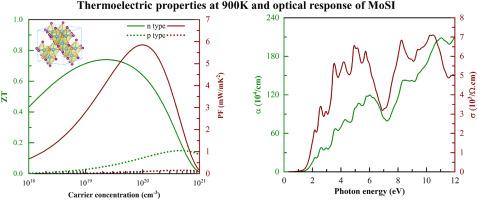MoSI的机械、光电和热电性质:DFT分析
IF 4.9
3区 材料科学
Q2 CHEMISTRY, MULTIDISCIPLINARY
引用次数: 0
摘要
利用DFT和玻尔兹曼输运理论研究了MoSI的结构、机械、电学、光学和热电性质,以评估其稳定性和作为环保安全能量收集材料的潜力。计算的晶格参数与实验数据一致,并通过弹性、热力学和声子计算证实了其稳定性。力学分析表明,MoSI在0 GPa时具有延展性,适合工业应用。电子能带结构表明具有半导体性质的间接带隙。在0 GPa和10 GPa时,光谱可见光区的最大吸收系数分别为44.61 × 104 cm−1和46.13 × 104 cm−1,对应的光导率分别为3.85 × 103 (1/Ωcm)和4.25 × 103 (1/Ωcm)。预测的吸收率表明该材料是一种良好的吸收剂,适合光伏应用。孔洞的有效质量随着压力的增加而减小,从而增加了孔洞的迁移率和导电性。压力效应的研究不利于MoSI中的热电输运,发现功率因数随温度和压力的升高而减小。在0 GPa时,在300和900 K时,n型MoSI的预测最大功率因数分别为10.2和5.88 mW/mK2。在0 GPa下,n型MoSI在300K和900k下的ZT预测值分别为0.45和0.75,对应的导热系数分别为7.25和5.38 W/mK。计算得到的导热系数远高于传统热电材料。由于较高的导热系数,ZT值降低,可以通过适当的掺杂、合金化或纳米结构等策略来降低导热系数,从而进一步提高ZT值。预测的有趣结果将能够引起科学界的注意进行实验验证,并使无铅MoSI成为高效能量收集装置的潜力。本文章由计算机程序翻译,如有差异,请以英文原文为准。

Mechanical, optoelectronic and thermoelectric properties of MoSI: A DFT insights
The structural, mechanical, electrical, optical, and thermoelectric properties of MoSI are investigated using DFT and Boltzmann transport theory to evaluate its stability and potential as an environmentally safe energy harvesting material. The calculated lattice parameters are consistent with experimental data, and stability is confirmed using elastic, thermodynamic and phonon calculations. Mechanical analysis revealed that MoSI is ductile at 0 GPa making it suitable for industrial applications. The electronic band structure indicates an indirect band gap with semiconducting nature. At 0 GPa and 10 GPa, the maximum absorption coefficient in the visible region of light spectra are estimated to be 44.61 × 104 cm−1 and 46.13 × 104 cm−1, respectively and the corresponding optical conductivity are 3.85 × 103 (1/Ωcm) and 4.25 × 103 (1/Ωcm). The predicted absorption is suggesting that the material is a good absorber and suitable for photovoltaic applications. The effective mass of holes decreases with pressure and hence increases hole mobility and conductivity. The study of pressure effect is not beneficial for thermoelectric transport in MoSI and it is found that power factors decrease with the increase of temperature and pressure. At 0 GPa, the predicted maximum power factor in n–type MoSI at 300 and 900 K are found to be 10.2 and 5.88 mW/mK2, respectively. At 0 GPa, the predicted ZT values for n–type MoSI at 300K and 900 K are 0.45 and 0.75, respectively and the corresponding thermal conductivities are 7.25 and 5.38 W/mK. The calculated thermal conductivity is much higher than conventional thermoelectric materials. ZT value is lower due to this higher thermal conductivity, and it can be further improved through the reduction of thermal conductivity by applying suitable strategies such as doping, alloying, or nano-structuring. The predicted interesting results will be able to draw the attention of the scientific community for experimental verification and make lead free MoSI as potential in efficient energy harvesting devices.
求助全文
通过发布文献求助,成功后即可免费获取论文全文。
去求助
来源期刊
CiteScore
7.80
自引率
2.50%
发文量
605
审稿时长
40 days
期刊介绍:
The Journal of Physics and Chemistry of Solids is a well-established international medium for publication of archival research in condensed matter and materials sciences. Areas of interest broadly include experimental and theoretical research on electronic, magnetic, spectroscopic and structural properties as well as the statistical mechanics and thermodynamics of materials. The focus is on gaining physical and chemical insight into the properties and potential applications of condensed matter systems.
Within the broad scope of the journal, beyond regular contributions, the editors have identified submissions in the following areas of physics and chemistry of solids to be of special current interest to the journal:
Low-dimensional systems
Exotic states of quantum electron matter including topological phases
Energy conversion and storage
Interfaces, nanoparticles and catalysts.

 求助内容:
求助内容: 应助结果提醒方式:
应助结果提醒方式:


